If you’re a Game of Thrones fan, you’ll recognize Diocletian’s Palace in Split, Croatia. Stay within the Palace walls to play your part in living history.
This article contains affiliate links and/or references to our advertisers. We may receive compensation when you click on or make a purchase using these links.
Table of Contents
Diocletian’s Palace in Split, Croatia has been a UNESCO Heritage Site since 1979. Its walled complex contains the Roman Emperor’s residential villa and temple sites, some of which were later converted to Christian churches. Just as important to UNESCO are the many medieval structures within the compound, boasting beautiful gothic and baroque elements.
But the best part about Diocletian’s Palace? It is one of the only heritage sites in the world where people still reside. This is truly living in history: a vibrant, relevant heritage which envelops the Palace’s beautifully preserved buildings and artifacts along with regional cultural traditions into a lively, modern-day community.

Diocletian’s Part in Roman History
Diocletian, whose reign lasted from 284-305, was a native Dalmatian who came from humble beginnings. Rising through the Roman military, he commanded the cavalry of Emperor Carus during what is known as the Crisis of the Third Century. With the Roman Empire under threat of collapse from a variety of inside and outside pressures, Diocletian succeeded the throne after the deaths of Carus and his heir, and cemented his power by defeating another claimant son in battle.
These events ended the crisis. Diocletian further stabilized the Empire by appointing a co-emperor (Maximian), and then two Caesars (Galerius and Constantius). This tetrarchy – “rule of four” – is reflected by their effigies at the Palace’s Golden Gate entrance.
Unlike at other significant and similarly intact archeological sites, people live, work and play within the walls of Diocletian’s Palace. Arriving in the late afternoon, we were captivated by its historic atmosphere and lively energy during an initial evening tour with our personable host. Click here if you are unable to see video below:
Built between 295-305, the seaside Palace contained residential apartments, lower level storehouses only recently discovered, public spaces where Roman subjects could gather, temples dedicated to Jupiter and Asclepius (the god of medicine – was this because Diocletian was already ill while the Palace was being built?), and a military garrison.
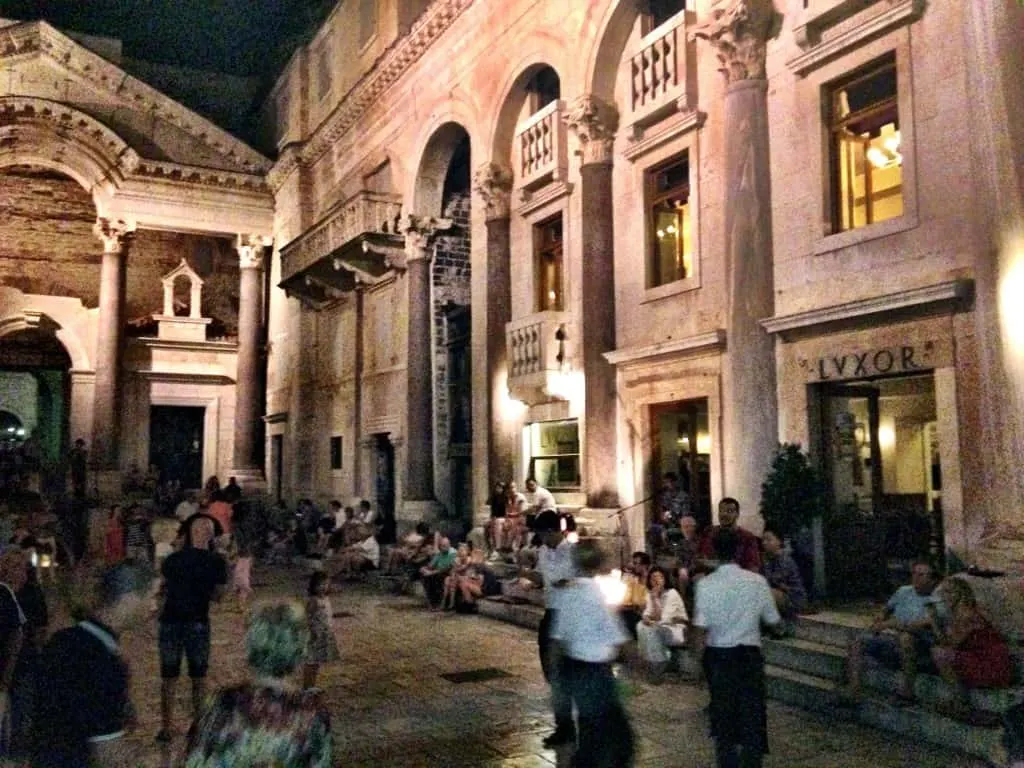
Roman Emperors believed they were descended from the gods, and Diocletian was no exception. While he set about restoring order and neutralizing the Empire’s Persian and Egyptian enemies, he also began to reinforce and reform.
Creating bureaucratic and military strength from a more equitable tax system, Diocletian went on to severely persecute Christians. His reasoning was that their faith threatened the traditional Roman religious hierarchy, of which he was arguably the most important part as the direct descendant of Jupiter.
The Temple to Jupiter and the Vestibule which transitioned visitors from public to private spaces at the Palace represented the close relationship Diocletian and his subjects understood himself to have with the supreme deity. The Vestibule’s oculus was a window from earth to sky through which his heavenly father could look down upon him, and he could offer sacrifices in return within the temple’s confines or even in the public Peristyle.
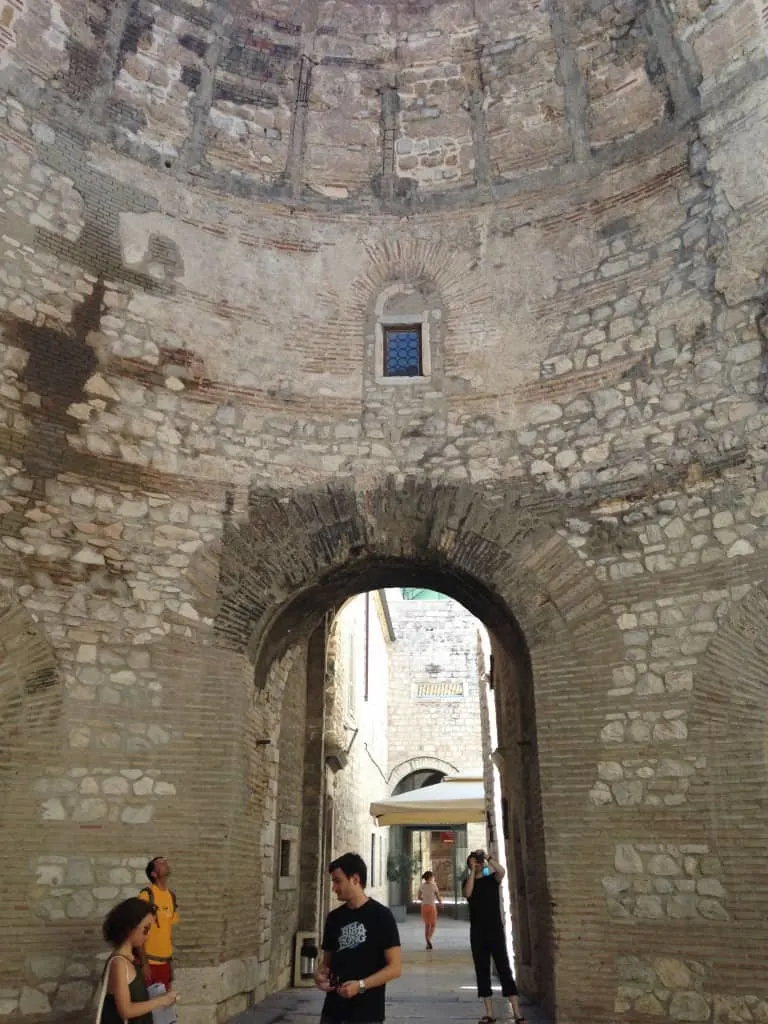

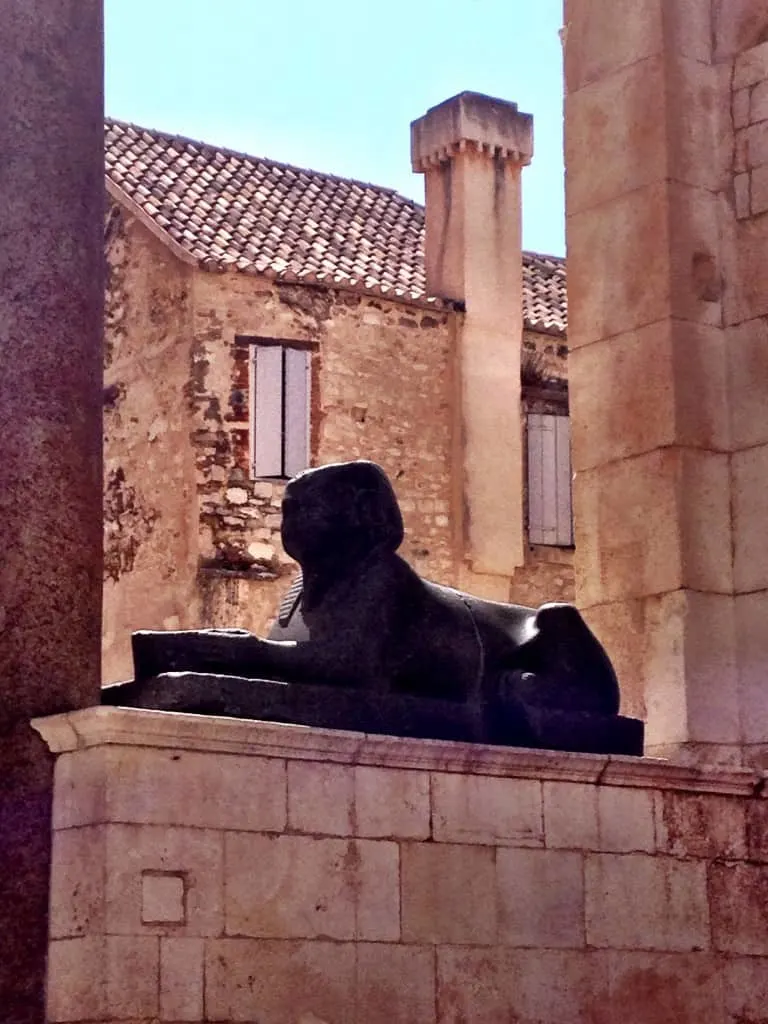
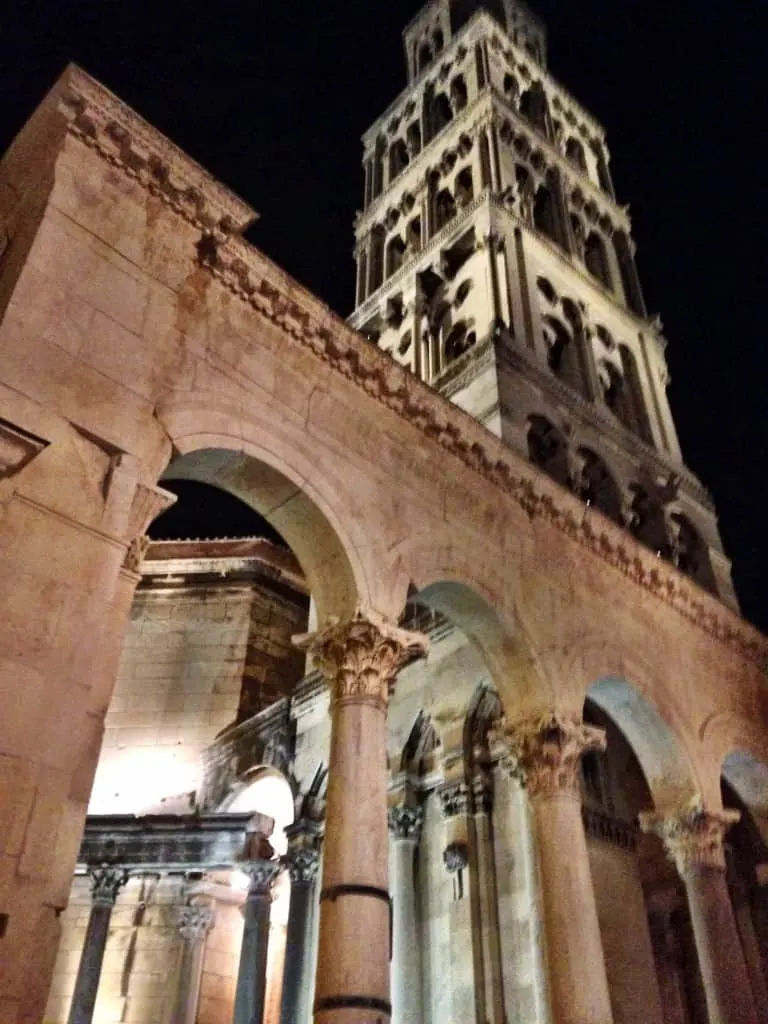
As his walled complex took shape from marble and local limestone, the Emperor’s health declined. Traditional lore holds forth that this project was intended from inception as a place to retire by the sea. In the spring of 305, after spending a couple of years at the Palace in failing health, Diocletian abdicated his title altogether, the only Roman Emperor to ever do so.
For several years thereafter, he delighted in his garden, fending off entreaties to return to office by stating, “If you could show the cabbage that I planted with my own hands to your emperor, he definitely wouldn’t dare suggest that I replace the peace and happiness of this place with the storms of a never-satisfied greed.” Distressed and increasingly ill, he died in 311.
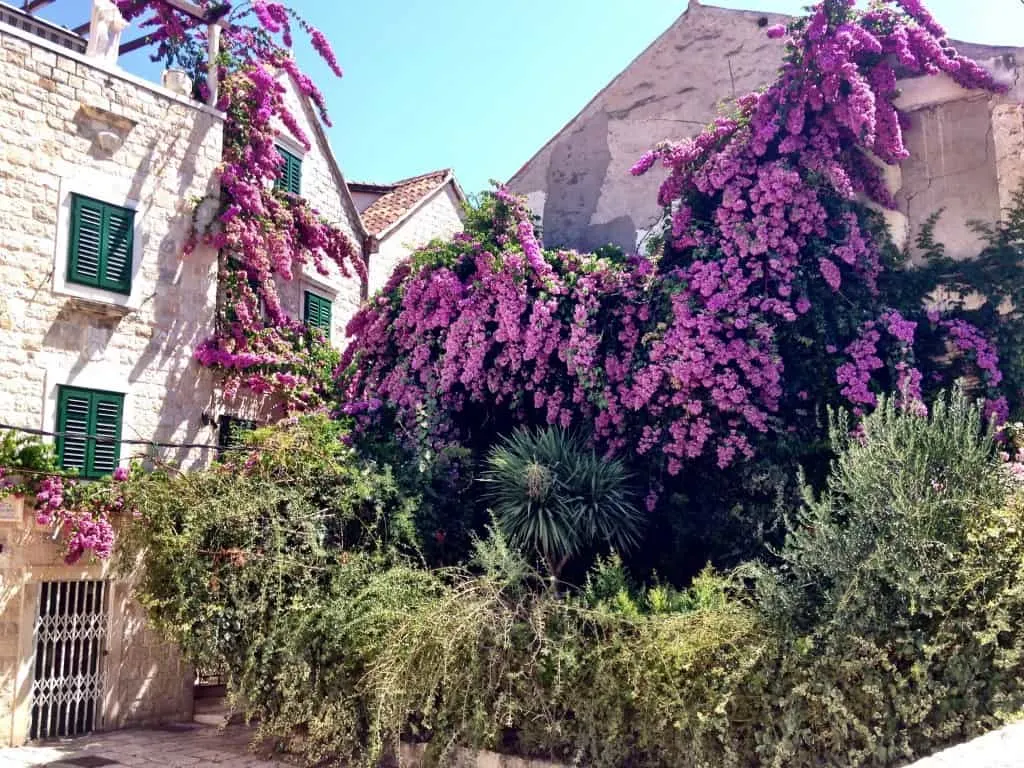
Architectural Significance of Diocletian’s Palace
Most experts believe that the southern facade of the Palace rose directly from the Adriatic, as pictured in the rendition below. But lately, Radoslav Bucancic, the Chief Conservator at the Ministry of Culture Conservation Office in Split, has determined this may not be the case. Excavations in 2006-7 revealed a wall at the end of a concrete layer approximately 12 meters deep by 180 meters long.
Because sea level in Diocletian’s time was lower, this structure would have been above the water line. The excavated seafront has subsequently been paved over. The Ministry of Culture’s beautiful magazine-style report takes a deep dive into all the archeological evidence at Diocletian’s Palace. It includes a photo of the excavation at the Riva waterfront where this discovery was made.
Today, the Riva is rather a grand promenade for pedestrians and disembarking cruise ship passengers.
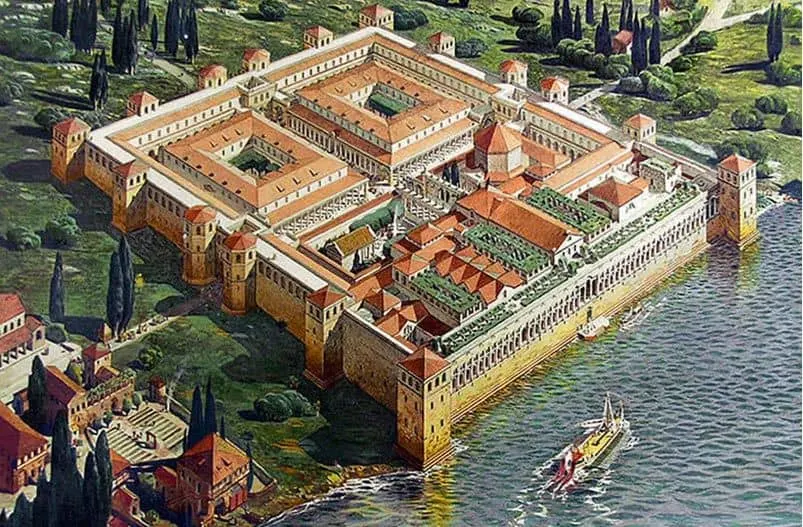
Diocletian’s Palace is Abandoned and Repurposed Throughout History
Left abandoned and uninhabited for several hundred years after the fall of the Empire, the compound was used as a refuge by Dalmatians fleeing 7th-century Croat invaders. They inhabited and repurposed the existing Roman buildings, beginning with the Emperor’s Mausoleum. This was consecrated as the Cathedral of St. Domnius.
Named for the Bishop who was decapitated by Diocletian in the city’s amphitheater, St. Domnius claims status as the oldest cathedral in Europe because of its provenance. Christians went on to rededicate and deface more of Diocletian’s constructs: the Cathedral’s crypt is now a shrine to St. Lucy, martyred by Diocletian; only one of his collection of Egyptian sphynx remains un-beheaded.

During Medieval times, baroque and gothic buildings went up inside the Palace walls, incorporating the Roman architecture.
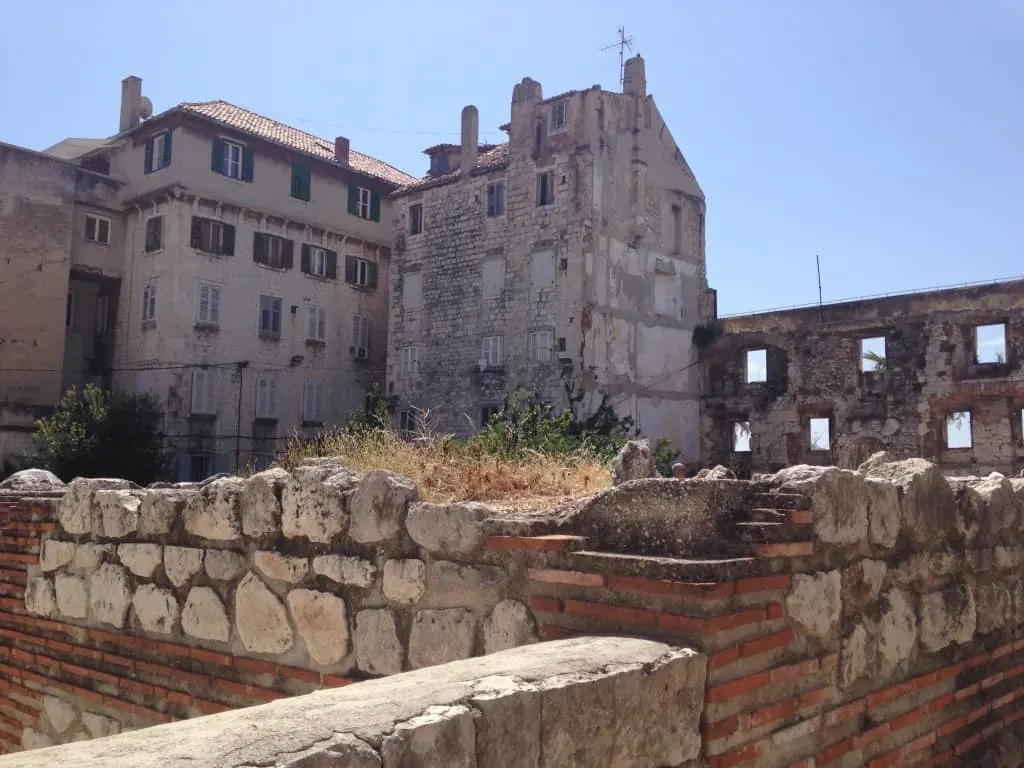
Multi-level dwellings and commercial spaces clustered around garden courtyards.

Rediscovered in 1764 by a Scottish architect, Diocletian’s Palace inspired Europe’s Neo-Classical design movement.
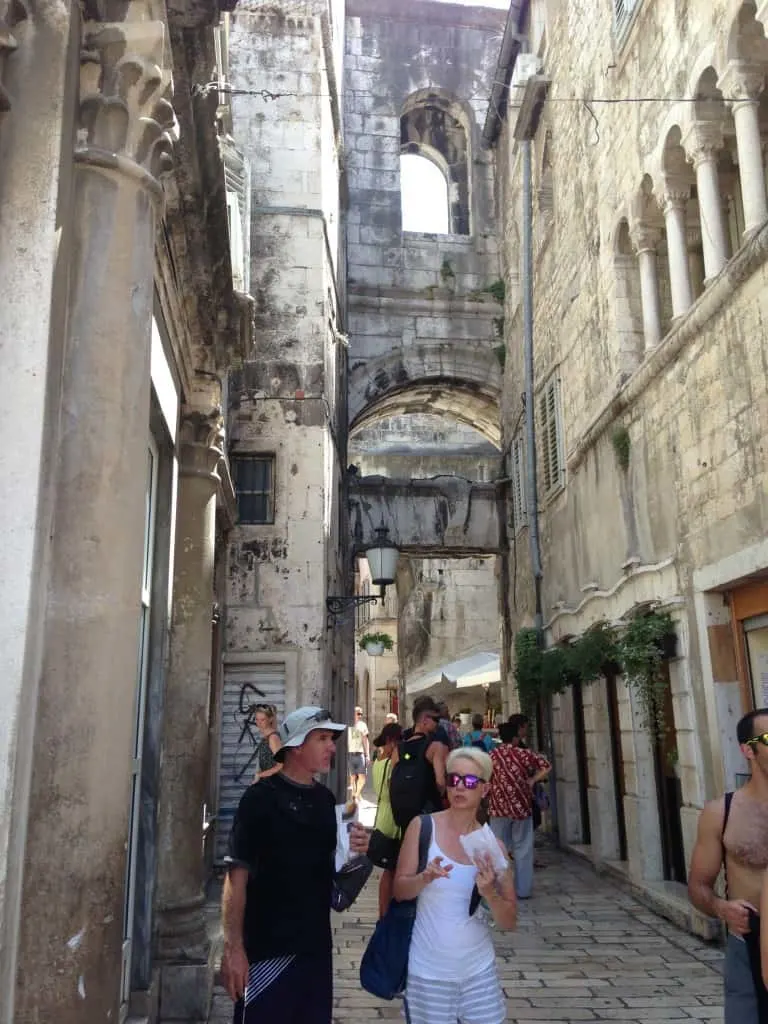
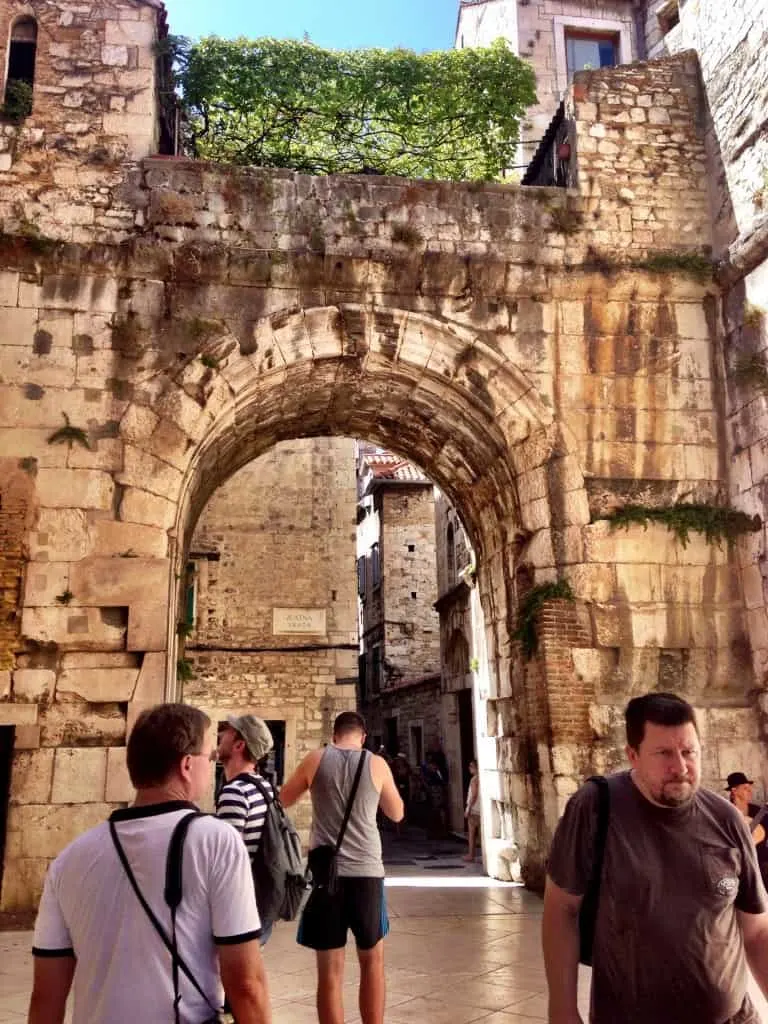

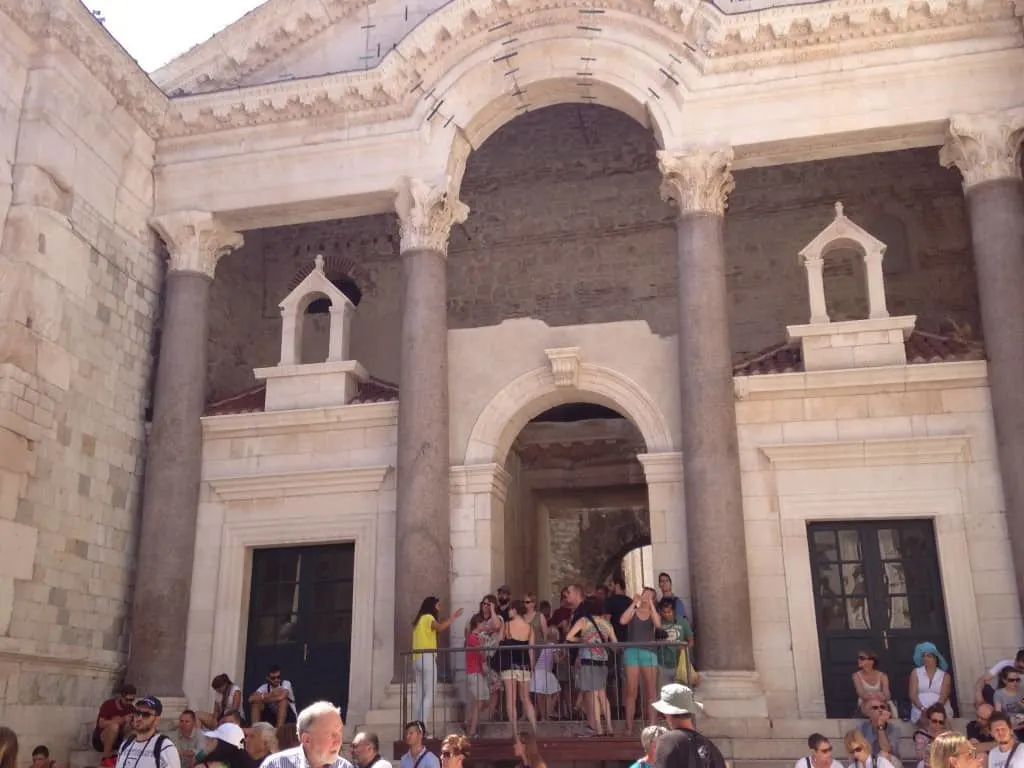
Rub Gregory of Nin’s Toe for Good Luck Outside the Golden Gate
Diocletian isn’t the only famous historical figure associated with the Palace. Our hotel room windows, close by the Golden Gate, looked out over an enormous statue of Gregory of Nin, which was moved from the Palace Peristyle to its present location after World War II. In the 10th century, Bishop Gregory introduced Croatian language religious services in defiance of the Pope’s Latin edicts. Today, you can rub the toe of the statue for good luck.
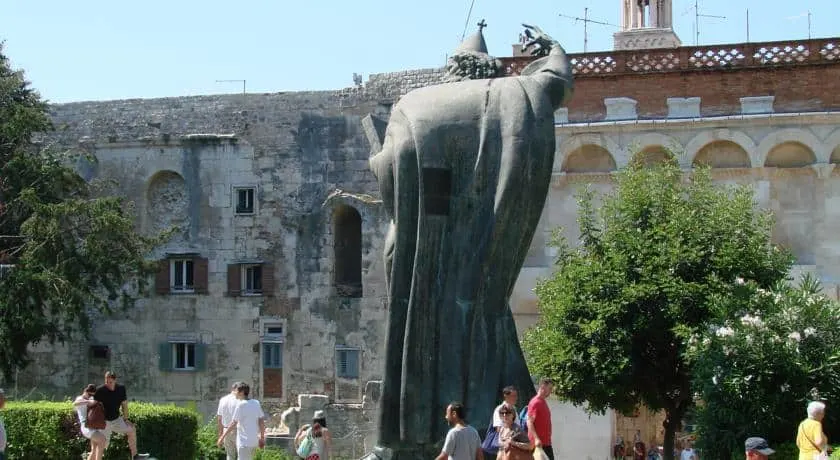
When you stay within the walls of Diocletian’s Palace, you are immersed in an atmosphere which is a lively combination of history and modern life. Currently, the Palace is home to approximately 3000 permanent residents. Our hotel host, Jerko (pronounced Yair-ko), told us this wasn’t always the most desirable part of town.
Gentrification of Diocletian’s Palace
The Yugoslavian government gifted Jerko’s father with a courtyard flat upon retirement which was a quite common thing to do in the formerly socialist state. The family has recently renovated it into our tiny hotel. Jerko joked that if the government had known how valuable this real estate would become, they never would have just given it away.
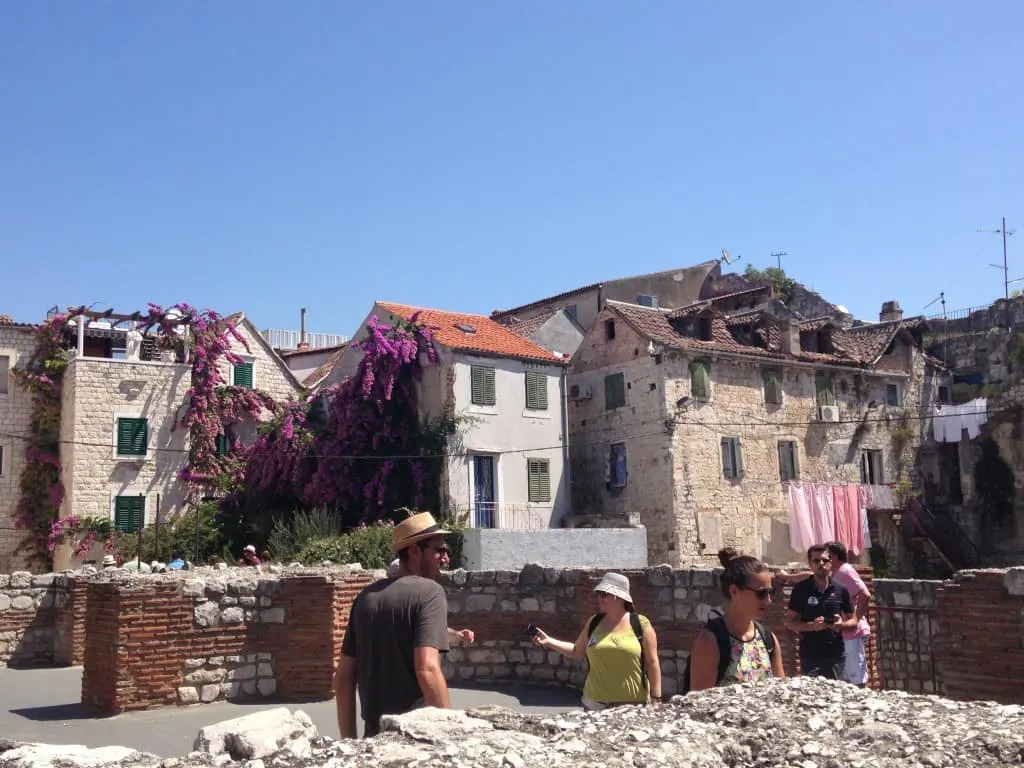
Since the collapse of the former Yugoslavia, the Palace has undergone gentrification and development. There are any number of places to stay within the Palace walls with prices ranging from budget to luxury. Likewise, dining and shopping options run the gamut.
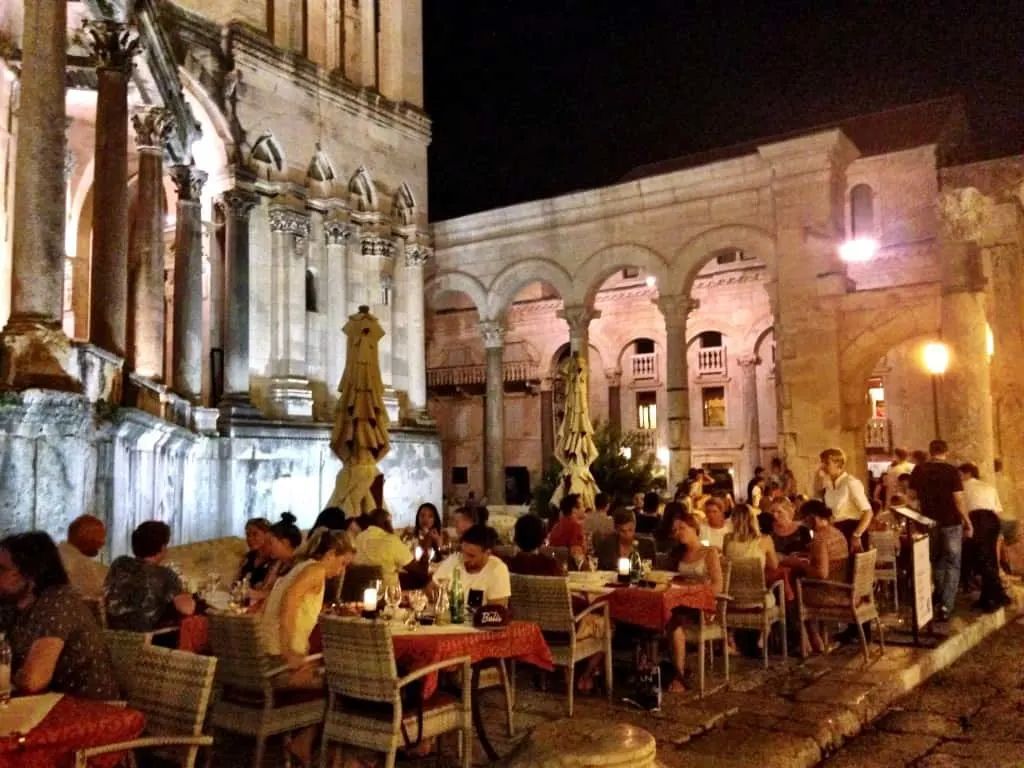
The vibe is paradoxical: it’s at once busy, yet relaxed. Innovation and renovation respect the historical elements for the most part, such as this architect’s striking concept for new housing on the southeast side of the Palace. Residents don’t hesitate to dispute and win against schemes which fail to respect historical heritage or reduce the small amount of green space that still remains within the Palace walls.
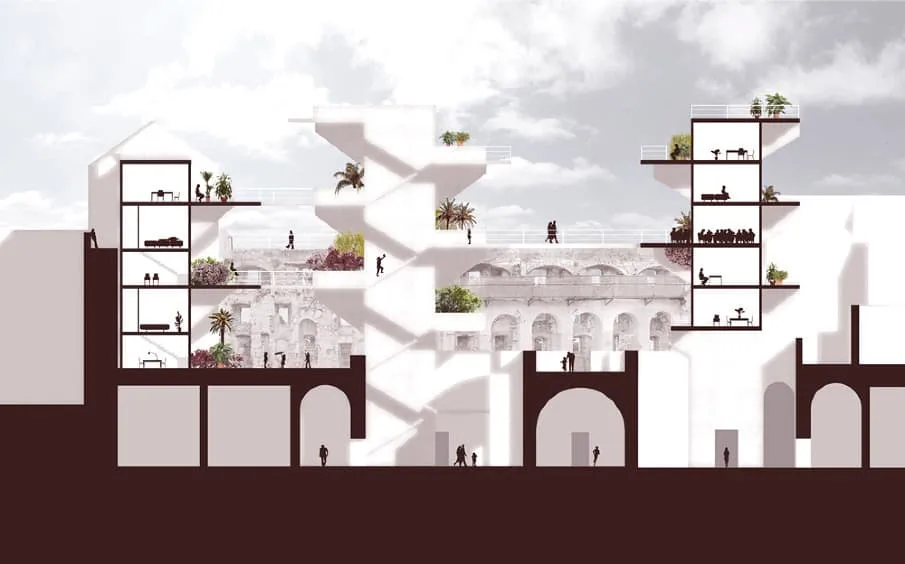
The Palace environs have a remarkable and practical physical relationship with the city of Split. Visitors, residents, and commercial deliveries enter and exit through the main gates – Gold, Silver, Iron – or from the Porta Aenea, a simpler gate from the sea side which may have been the Emperor’s private access or used as a service entrance.
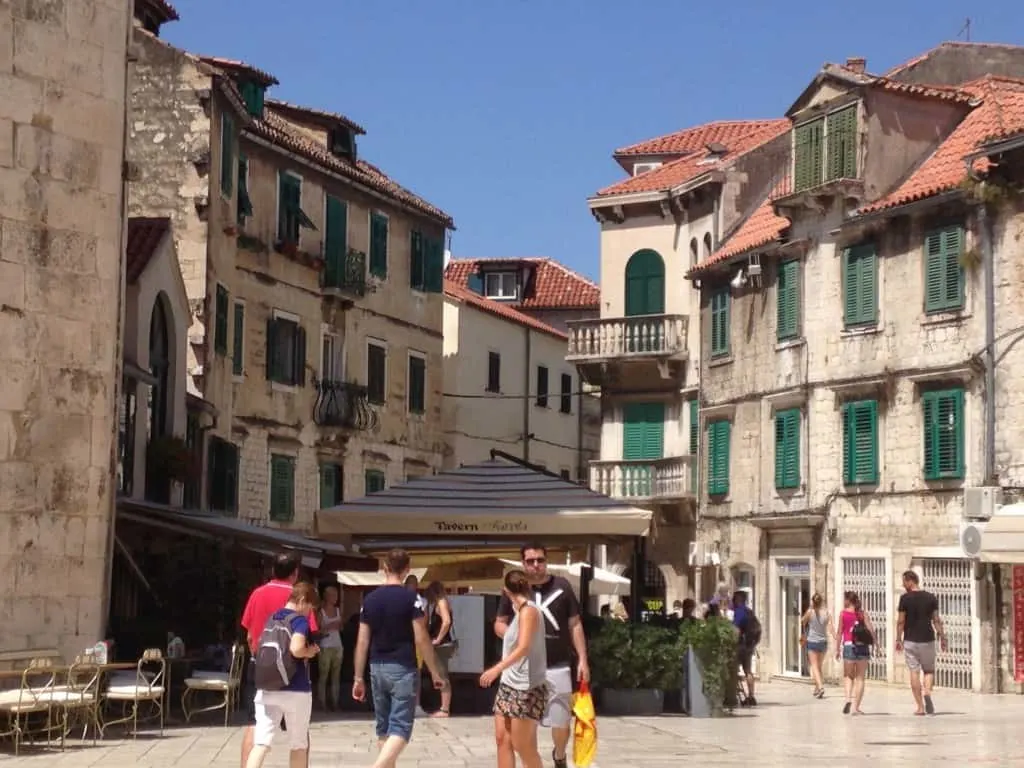
Even as you live in history at Diocletian’s Palace, you need not feel confined by it. Instead, history defines and enriches your experience with an injection of the cheeky Croatian personality. See what we mean in the “Emperor’s Procession” video below, so kitschy:
Know Before You Go
We stayed at the Guesthouse Palace Inn, where you may choose from one of two ensuite rooms, each with sitting area, air conditioning, refrigerator, cable TV, coffee and tea making facilities. Our wonderful hosts, Jerko and his family, have renovated their father’s retirement flat with a clean minimalist look while simultaneously incorporating classical details from the Roman exterior wall.
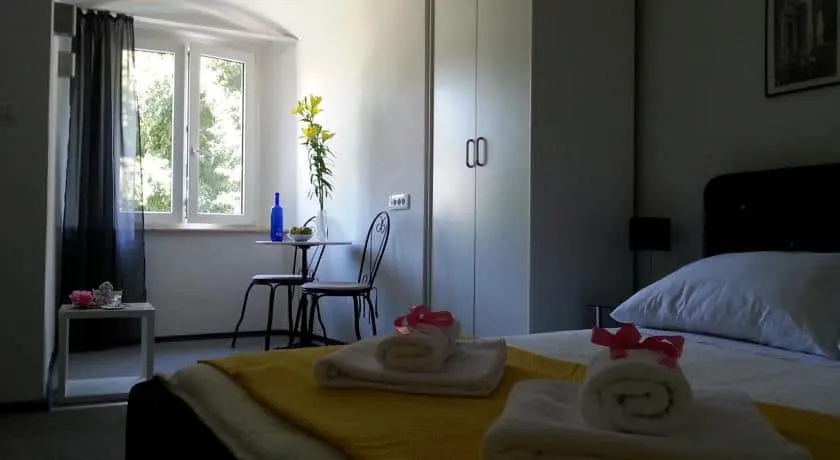
We arrived having driven from Rijeka. The hotel is located off a courtyard in the vicinity of the Golden Gate. New visitors without a detailed map may be disoriented on their first foray inside – Google Maps are not reliable here. If that’s all you have, you might best wait outside the Palace wall after telephoning for someone to meet you.
Parking in the center city, particularly on busy holiday weekends, may seem a nightmare. Jerko will help you find a space in the neighboring streets. Inside the Palace walls, it’s pedestrians only. We chose to drop off our Sixt car rental in Split after the first night.
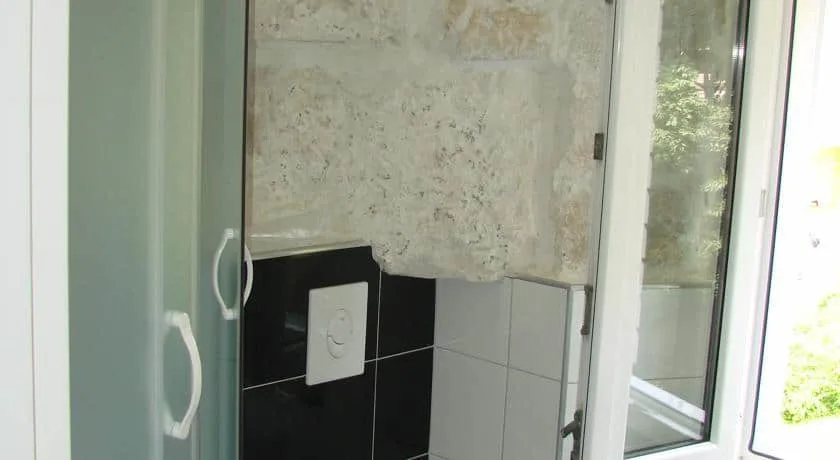
Many visitors arrive in Split via cruise ship or ferry, as it has long been a popular stop and gateway to the Dalmatian coastal islands. Ferries are frequent from Hvar, Korcula and other islands. You may come by sea from the coastal cities of Rijeka, Zadar and Dubrovnik as well. Check schedules and ticket information here.

To see our other posts about attractions and destinations in Croatia, click here.
Tips for Trip Success
Book Your Flight
Find an inexpensive flight by using Kayak, a favorite of ours because it regularly returns less expensive flight options from a variety of airlines.
Book Your Hotel or Special Accommodation
We are big fans of Booking.com. We like their review system and photos. If we want to see more reviews and additional booking options, we go to Expedia.
You Need Travel Insurance!
Good travel insurance means having total peace of mind. Travel insurance protects you when your medical insurance often will not and better than what you get from your credit card. It will provide comprehensive coverage should you need medical treatment or return to the United States, compensation for trip interruption, baggage loss, and other situations.Find the Perfect Insurance Plan for Your Trip
PassingThru is a participant in the Amazon Services LLC Associates Program. As an Amazon Associate I earn from qualifying purchases.
To view PassingThru’s privacy policy, click here.

Top 10 Sofia Attractions for First Timers | Passing Thru
Thursday 28th of April 2016
[…] the Emperor Diocletian (see our write-up on his retirement palace in Split, Croatia) divided its province into two, Serdica became one of the new capitals. In 311, […]
Bruno
Friday 8th of April 2016
I just loved this place. Having a beer with live music on a hot summer night surrounded by these ruins was magic!
Betsy Wuebker
Friday 8th of April 2016
Hi Bruno - We loved it, too. There were many moments in Split which proved life is good.
Doreen Pendgracs
Sunday 3rd of April 2016
I'm not a Game of Thrones fan, and haven't yet been to Croatia, but I would certainly like to go. GREAT pics!
Betsy Wuebker
Sunday 3rd of April 2016
Hi Doreen - I haven't found a soul who hasn't loved Croatia, GoT fan or not. :)
Romantic Rovinj | Passing Thru
Sunday 3rd of April 2016
[…] medieval town, whose lone church bell tower – that of Saint Euphemia (martyred by Diocletian, whose Palace we visited in Split) in Rovinj – points skyward from the center of a spiral of red-tiled roofs. Like a […]
Jo ~ Lifestyle Fifty
Sunday 3rd of April 2016
Loved your photos Betsy and they brought back fabulous memories of our time in Croatia and Split. We stayed in a tiny guest house on the top floor in the Diocletian's Palace, quite near to the restaurant you feature in one of your photos. Just loved Split ... the ancientness of it all, the wonderful atmosphere, the restaurants, that gorgeous look out hill and the ability to hop on a boat or ferry and go to an island. Awesome Croatia. Great post :)
Betsy Wuebker
Sunday 3rd of April 2016
Hi Jo - You're so right. Croatia is simply awesome, and Split is a lovely experience. Thanks.